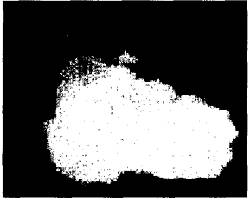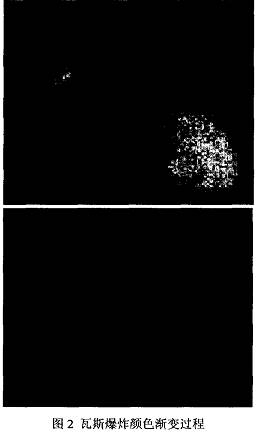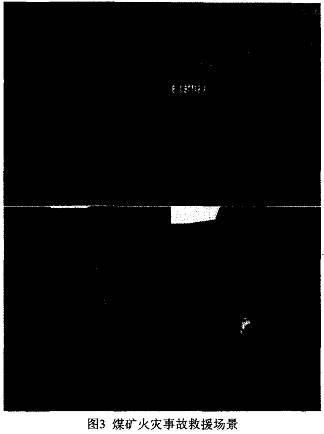Design and Implementation of Virtual Coal Mine Accident Rescue Training System 0 Preface In recent years, China's coal mine emergency rescue work has played an important role in reducing casualties and property losses in mine accidents and promoting mine safety. In the rescue, the success of the rescue operation depends on whether the rescue team can make decisions quickly and correctly, and these depend on the quality of the rescue personnel and their usual training level. Using virtual reality technology as a training and learning tool, you can simulate or reproduce a real environment. Ambulance members can try to take various rescue measures by entering this virtual environment to obtain training. Introducing the game into the training process makes the training interesting and attractive, thereby stimulating the enthusiasm of the ambulance team members for learning and training, and making the team members better trained. This article will introduce the design and implementation of a coal mine accident rescue training system based on virtual reality. Part 2 describes the overall structure of a virtual coal mine accident rescue training system. Part 3 discusses some of the key technologies used in the system. Part 4 Part describes the function of each module of the system in detail, and gives the simulation of gas explosion accident scene and the simulation of coal mine fire accident rescue training scene. Part 5 gives the conclusion. l Overall structure of virtual mine accident rescue training system The virtual mine accident rescue training system is mainly used for accident rescue training of mine ambulance team members. It is proposed to use computer technology to establish a set of interactive simulation training system that simulates the whole process of receiving alarms, dispatching and on-site command. The system mainly includes the following aspects: 1) Simulation of roof fall, fire, flood, gas and coal dust explosion accident process; 2) Preparation of various accident rescue plans; 3) Automatic evaluation of the effects of various accident rescue programs; 4) Provide basic coal mine knowledge and complete rescue knowledge. The virtual coal mine accident rescue training system uses virtual reality technology to reproduce the accident scene in the computer. Players can be manipulated like a PRG game. You can be in a real coal mine, you can experience all aspects of the coal mine and complete various training tasks. It mainly trains the ambulance team members to deal with unexpected accidents in real time, how to ambulance and reduce the loss to the minimum. Rescue team members make correct rescue judgment through their own experience and the reference guidance given by the training guidance system. Figure 1 shows the overall structure of the virtual coal mine accident rescue training system. 2 Key technologies of virtual coal mine accident rescue training system 2.1 Key technologies of virtual coal mine accident rescue training system 1) Key technologies for building 3D models The coal mine accident rescue training system mainly uses virtual reality technology to reproduce the accident scene. Therefore, when constructing the 3D model, in view of the particularity of the coal mine itself, due to the complex geological structure conditions and the variety of mechanical equipment and other special conditions, it directly caused the complexity and diversity of the mine model. It is difficult to guarantee the effect of real-time roaming on the model. The experiment found that the use of multi-level of detail model technology can better solve similar problems. In order to increase the realism and three-dimensional sense of the entire scene, when building a model of a building, etc., texture mapping is used to control the complexity of the scene and accelerate the speed of drawing graphics. 2) Particle system modeling The particle system method is to gather a large number of particle primitives together and express the physical characteristics of the object through the change of its attributes. Each particle has random shape, size, color, transparency, direction of motion, and speed of motion at any time, and its position and shape change with time. The properties and dynamics of each particle are explained by a set of predefined random processes. Particles go through three stages of generation, movement and extinction in the system. Various properties of particles in these three stages change at any time, so as to fully reflect the dynamics and randomness of irregular objects. In the virtual coal mine accident rescue training system, the logical structure of objects such as flames, smoke, water beams, and explosions in the scene is difficult to express, and it is difficult to express them with several primitives. The particle system is suitable for such objects. 3) Collision detection In order to make the virtual effects of the mine accident rescue training system more realistic, collision detection is necessary. There are thousands of moving objects in the virtual scene of the coal mine. The geometric complexity of this virtual scene increases the computational complexity of collision detection by the National People's Congress. However, accurate collision detection contradicts the real-time nature of the system. Therefore, a data structure is needed to effectively manage the scene. The binary space splitting tree (BSP tree) is an effective management method for the scene. However, due to the static characteristics of this spatial data structure, it is difficult for them to deal with dynamic scenarios. For this, a fast algorithm based on BSP tree is used to manage the entire scene, a kind of semi-adjustment. This algorithm is mainly used to deal with collisions of dynamic objects. It does not need to completely rebuild the tree, and the BSP tree structure can be partially adjusted to achieve the most suitable balance state and maintain the highest characteristics. You can use a scheduling algorithm to evaluate where the BSP tree starts to be out of balance, and use some strategies to choose to change the split plane, thereby reducing the cost of the tree structure change caused by the update. 3 Virtual coal mine accident rescue training system 3.1 Accident scene simulation system The coal mine accident simulation system mainly includes: simulation of roof fall, fire, flood, gas and coal dust explosion. Due to space limitations, this article takes gas explosion simulation as an example. Because gas explosion, burning, and smoke scenes are generated by the random movement of countless small particles, not only is the shape of the appearance extremely irregular, there is no fixed shape, the randomness is large, but more importantly, its color, shape and even the sound change constantly, making The simulation of the above scenario becomes very complicated. Experiments have proved that the more successful simulation method is the particle system algorithm. The explosion is generated by defining the number of particles, assigning initial values ​​to the new particles, and generating these particles in the system. Application of particle system algorithm should define the main properties of particles: life cycle, number of particles, shape of particle source, size of particles, diffusion speed of particles, color of particles. The simulated scenes of explosion, burning and smoke change their color, shape, position and direction according to time to achieve the effect of real-time change. Therefore, when the particle system is used to simulate scenes such as explosion and combustion, dynamic control and changes are required. The operation process of the particle system is as follows: Throw initiating particles When Cheng Ning is executing Women's bag particles did not die According to the speed of the particles, the position of the particles is changed According to the speed of the particles to update the grain to cover thin Modify the energy of particles If the energy of the dye is less than a certain threshold Set particle state to drunk Hoe particles hit the scene object or other particles Modify the short pitch, J, 1, speed and energy of particles Show grain Cheng Yu ends During the explosion, the color of the smoke produced by the explosion changes with time. Therefore, the treatment of the color of the explosive mixture is very important. According to common sense, the color of the explosive mixture at the beginning of the explosion should be mainly silvery white in a mist shape, then change to orange yellow, and finally red becomes the main color. Over time, the color of the flame should gradually turn yellow, gray, and finally black. Figure 2 shows the gradual process of the gas explosion color. At the beginning, it was dominated by silver and white, then changed to orange, and finally red became the main color. 3.2 Design of virtual coal mine accident rescue training system The rescue training system mainly uses artificial intelligence technology to guide the trainers. The virtual coal mine accident rescue system includes: basic training module, expert knowledge module, guidance decision-making module and training evaluation module. The functions of each part are defined as follows: Basic training module. This module is mainly to complete the basic training for the players. This module is responsible for recording the static information of each player: such as the position of the player, preferences and fears, and the dynamic information of each player during the training process: such as the tasks that the player has completed, the experience gained, rewards, punishment, all Dynamic information such as physical energy consumed, remaining vitality value. Through these to feedback the player's physical, psychological state and training level, and set the corresponding value. Then the evaluation module judges the training level of the team members and whether the team members pass the training through the minimum evaluation standard. For qualified players, it means that they have succeeded in tackling key problems, and the various points of the players will increase or decrease accordingly, and they can enter the next stage of training. In this system, according to the severity of each accident in the coal mine, it is divided into 4 levels. Each level has a scoring system, which can be scored according to the performance of the players to break through the level, so that the players can hone their fighting spirit in the difficult process of attacking the key. To develop skills and improve your abilities. As the difficulty of research is increased, the more complicated the accident is, the more likely the players will be terminated due to loss of life. Therefore, players must learn to save vitality and reduce casualties as much as possible. Expert knowledge module. This module includes the basic knowledge base and expert decision knowledge base that the trainer must master to complete all tasks. The content of the expert decision-making knowledge base is mainly extracted from the work of experts with rich practical experience in handling coal mine accidents. Including: determination of disaster avoidance routes; determination of escape routes; selection of rescue measures, etc. It provides a basis for guiding decision-making. Guide the decision-making module. This module is the core module in the rescue training system. It is responsible for providing guidance strategies. Such as error correction prompts, help prompts, evaluation prompts, etc. of the team members during the training process. It analyzes the types of accidents and the severity of accidents of the current team members, and gives the best rescue plan based on the expert knowledge decision database. Of course, players can make decisions based on their own guidance and decisions. Training evaluation module. An approximate objective estimation and evaluation of the training results, that is, the training effect. The minimum assessment requirement is that the life value of the trained ambulance team member is greater than zero, that is, to leave the accident scene alive. For the ambulance crew to leave the accident scene alive, the comprehensive evaluation result is obtained by combining some dynamic information such as the training time, the psychophysiological status of the basic training module, and the best escape or rescue route of the expert knowledge module and decision guidance module. This article is: the combination of t, ~ OpenGL and Vc ++ on the Windows platform to achieve a virtual mine accident rescue game-based training system based on C / S structure. Users can browse and automate the entire scene in a virtual way, and can also interactively control the entire mine accident rescue training process. System configuration using OpenGL and Visual C ++ compiler settings: dynamic link library: GLU32 DLL, OPENGL32 DLL (put in C: \ WINDOWS directory \ system32) Header file: GL. H, GLAUX. H, GLU. H (put in C: WrogramFileskM icrosoft Visual Studio \ VC98klnclude \ GL) Library files: GLAUX LIB, GLU32. LIB, OPENGL32. LIB (put ~ ljC: Wrogram FileskMicrosoft Visual Studio \ VC98 ~ IB) Open the menu Project \ Settmgs, select the Link tab in the pop-up dialog box, and add in the Object ~ Libaray Modules-- column) JHGLU32 LIB, 0PENGL32. LIB these two files. The user is represented by an avatar (Avatar) in the scene. When entering the game training, the user can select an idle Player as his avatar. In each scene, he needs to select the corresponding equipment, perform the corresponding operation, and obtain the corresponding points. Deduct points to complete the purpose of training. Figure 3 shows the simulation process of a coal mine fire accident rescue training scenario: a fire is detected and the police dispatches a fire extinguishing process. The first is that the trained team member discovers the fire and reports the fire situation to the superior (location, gas, temperature, ventilation facilities, tunnel damage, etc.). Then according to the command, carry out rescue operations. 4 Conclusion The virtual coal mine accident rescue training is a simulation of the rescue training process, the purpose is to enable the rescue team to master the rescue technology in the virtual environment provided by the computer. Through the process simulation, the scene of the coal mine accident is reproduced, and the rescue team is presented with a realistic three-dimensional visual environment, as if they were immersed in the virtual environment of the coal mine accident. In addition, the virtual coal mine rescue training system combines games with education and practice, and entertains and trains, which greatly improves the imagination of the players, stimulates the students' interest in learning, strengthens the learning effect, and improves the ability of the players in the game. And experience happiness in training.
This is the most competitive 15.6 inch Budget Business Laptop, comes with 2022 intel latest celeron cpu-N5095, J4125, etc . Of course, other Budget Working Laptop are also available.
For example, 15.6 inch i5 4th Budget Workstation Laptop for your mid-level task, 14 inch i5 10th Budget Laptop For 3d Modeling, 15.6 inch i7 5th Budget Laptop For Photoshop, or 15.6 inch i7 10th budget laptop for work, etc. Of course, there are other type device, like Android Tablet, 2 In 1 Laptop , Mini PC , All In One PC.
A thin, portable, light-performance laptop may be the ideal tool when people choose a business laptop, therefore just ask yourself 1.what jobs you mainly need this device to do, then choose the cpu and storage necessary, 2.if need fingerprint or backlight; 3. prefer type C charging? Or traditional DC is ok? 4. Does RJ45 webcam is important for you? 5. how many hours you need the laptop to work when do your main jobs?
6.Camera position, prefer on the middle of screen up? or is ok on the bottom of screen?
Budget Business Laptop,Budget Working Laptop,Budget Workstation Laptop,Budget Laptop For 3d Modeling,Budget Laptop For Photoshop Henan Shuyi Electronics Co., Ltd. , https://www.shuyipcs.com


